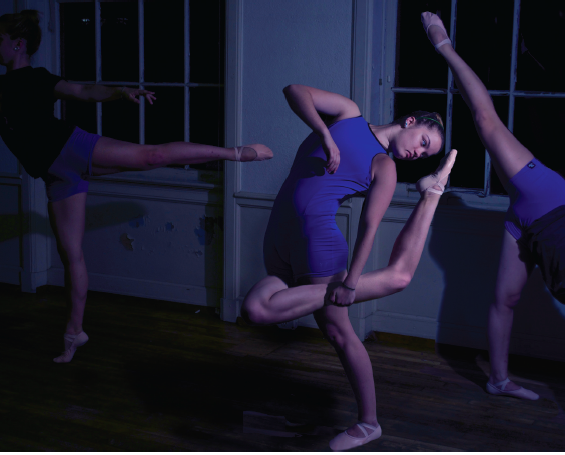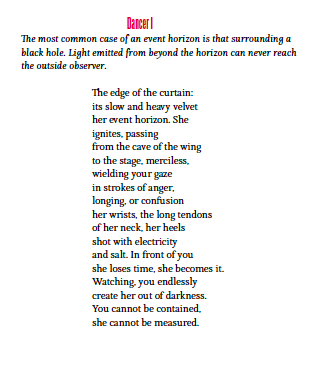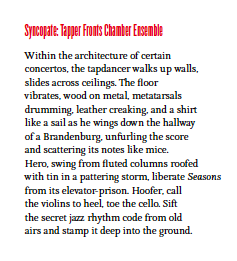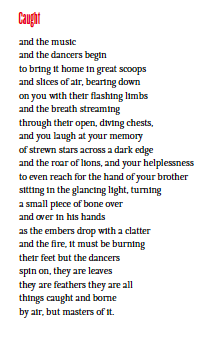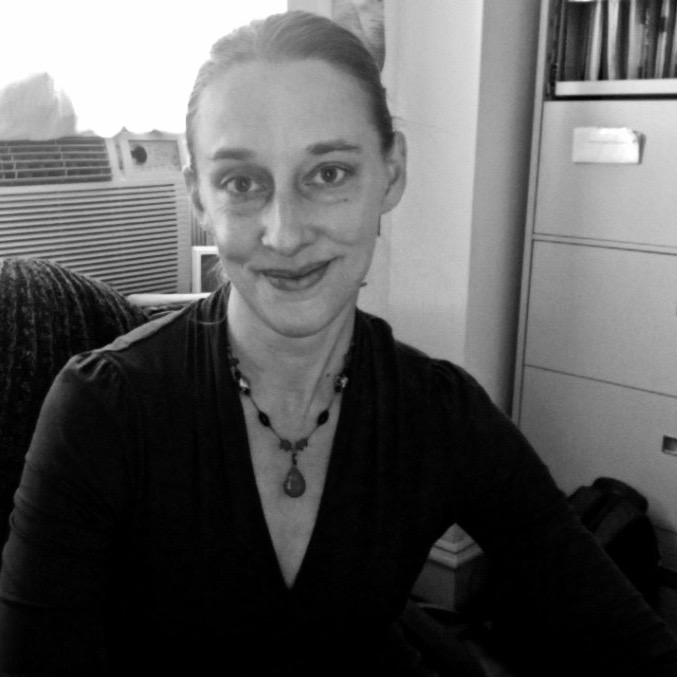“I can’t talk about what I have just seen, nor explain why it has moved me. I can only weep and stagger up the street … my command of language has failed. The dance has won.”
“The Dance Vanishes / The Poem Remains” first appeared in our “Bedeviled” issue in 2015 and has been specially formatted here for online reading. You can also find it in slightly different form on Medium.
Citation: Broad Street 2.1, “Bedeviled,” pages 58–63.
Click on Lea’s poems to see them in large, clear format–and to print them out as broadsides.
*********************************************************************************
The Dance Vanishes / The Poem Remains
By LEA MARSHALL
I. Catch Me If You Can
I am trudging up a steep cobblestoned street in Edinburgh, and I am sobbing. I have just emerged from Saint Stephen’s church — dark, tall, and at the bottom of a long hill — which has been repurposed as a performance venue during the Edinburgh Festival Fringe. I can’t talk about what I have just seen, nor explain why it has moved me. I can only weep and stagger up the street. This is problematic, since I attended the performance as a dance critic — a person who translates the ephemeral, three-dimensional, kinetic experience of dance into written language. A person, some might say, given to pride and folly, since now my command of language has failed. The dance has won.
I decide to confess.
Watching Derevo’s Ketzal means being buffeted by sound, light, writhing limbs, rolling eyes, flickering fingers, until you no longer try to understand what you are seeing but simply watch. And watching in that receptive state invites a flood of feelings — powerful and elusive of definition — that you could not otherwise experience. The Russian dance-theater group’s work can bring about true catharsis, and as I sat unexpectedly weeping, I understood for the first time what that means.
— Dance Magazine online, September 2006
— — — — — — — — — — —
I was trained in writing from a young age and in dance from a much older age than most girls. Over a decade ago, I was invited to write my first dance review — a terrifying prospect for an English major. A dancer, sure, but in a Johnny-come-lately sort of way, long and lean perhaps, but kinesthetically naïve compared to the artists I hung around with, most of whom started dancing at the age of four. Who was I to critique the likes of Bill T. Jones?
All of that ego fell away when I attended a lecture demonstration in which Jones, solo, danced, spoke — spoke — showed video clips, and answered questions about his thirty-plus-year career. Physical and verbal language wove seamlessly into a performance.
In my newness, I let him speak for me:
When asked about dance in the present and future, Mr. Jones reveled in the fact that contemporary dance changes continuously, defies definition, and is by nature ephemeral. “Dance,” he said in his rich warm voice, “is like the goddess out of the box, saying, ‘Catch me if you can.’”
— C-ville Weekly, April 2003
This was the same box that Derevo smashed to pieces for me in Saint Stephen’s church three years later, when I thought I might understand a little something about writing dance. We have seen how that ended — in tears.
II. A Prehensile Question
When I lecture on dance criticism, I spend a lot of time breaking down the ways I interpret dance on my audience’s behalf, through their eyes. A non-dance audience will first see technical skill, physical prowess: How does she get her leg up there? Next, they may look for narrative: What is happening in this dance? What is the story?
I look for structure and more abstract ideas: What is this dance about? What am I about– feeling, thinking, watching this dance?
But often at the core of a review lies imagery or comparison via metaphor or simile — an attempt to bridge the gap between concrete language and ineffable experience.
Four pas de deux, fast, rich, and dense, composed the bulk of the dance, punctuated by pauses in which a woman might thrust one foot forward in a forced arch, a tilt of her head transforming her body into a prehensile question.
— Dance Magazine, June 2006
I am a poet. Imagery seduces me. I cannot resist writing this transformation of a woman’s body into a prehensile question by a tilt of her head. But the transformation takes over as I quail before the task of capturing this Kirov Ballet performance at the Kennedy Center. I have not recorded the experience; I have turned it into art of my own, honoring the fact that the dance sometimes begets language, but language can never truly capture the dance.
III. Your Body a Parachute
If you visit a dance class, listen to the teacher. Listen to her voice, the words she chooses, the imagery she uses. Because dancers and their teachers hold a secret so close some might not realize it’s there — that, like music or emotion, language (as I slipped in above) begets dance within the body. Through language, dancers can deepen their embodiment of a movement, a step.
There is the irony — that dance once performed cannot truly be captured by language, but its performance can be manifested in part through the life of language within the body.
The pink-tutued three-year-olds in your nephew’s recital have most likely been told to grow tall and open their arms like flowers blooming. I myself have stood at the ballet barre and spread my toes, exhorted by my teacher to root my feet into the floor like a tree into earth. I have balanced in an arabesque as the teacher spun an image of puppet lines pulling my limbs longer and higher. I have imagined an eye opening wide in my throat to lengthen my neck.
I am imagining it right now. It is working. My breath deepens.
— — — — — — — — —
Visiting a dance composition class today, I talked about metaphor and imagery. I asked the students about the images their dance teachers had conjured in their minds that engendered an immediate and memorable physical response. They grew excited — hands went up fast, ready to echo what their teachers had said:
“My shoulder yawning.”
“Painting the floor with my limbs.”
“Feeling resistance in my arm, like holding it out the window of a speeding car.”
As they spoke, their bodies echoed the words that had now become their own. One young man rolled his shoulder slowly back; a woman swept her leg across the floor while sitting; and another man held out his arm and pushed it slowly forward.
— — — — — — —
As with any other athlete, dancers work to integrate their kinesthetic understanding at a level that no longer requires conscious thought. But until they reach this advanced stage, language helps to shape their understanding and performance of dance technique. Teachers know that where the mind goes the body will follow.
Water and wind images — forces of resistance — can invest dancers’ limbs with weight and power. A dancer tells his students, “Imagine you are wearing heavy hiking boots walking upstream, or walking slowly through water with a crust of ice on top. How does this affect the way you move? Water and wind also buoy.”
In a plié, says a ballet teacher, “think of your body as a parachute that billows open.”
Another friend writes about how the image of a fire hose — strong and filled with water — helps her ballet students find a “supple tension” in their arms. Further, she writes, “I also like the image of wings on their backs that are attached at the bottom of their spines and move up through the ends of their fingertips. This helps them engage the back when lifting the arms.” Thus swans are born.
Speed and attack can be invoked by the image of a match striking, or a switchblade.
My foot sparks.
My legs slice.
Light gleams along my blade.
For the most part, dancers work without speaking aloud. So I am dwelling in these examples, these moments of embodied imagery, for a while, to honor the action of language in dancers’ lives.
Of course, dance itself is a language, my philosopher friend reminds me as we sit eating Thai food in my dining room. Perhaps even the first language, long before speech, eons before writing. With movement we communicate from a distance and yet also within breath of each other, within each other. In the womb, we press our heels against our mother’s walls and her hand finds us out.
IV. Diving Into the Wreck
Yes, I was a writer before I became a dancer. Language lodged itself first in my heart. At every moment, words overtake me, prickle beneath my skin; I cannot stay them. My breath catches — at a rush of love, of outrage, longing, or fear — and the words come, rushing arcs of them sometimes, or a single phrase around which I build again a home. I construct my world from words.
Sometimes it drives me crazy. I lurch out of bed for the computer. At stoplights I fumble for paper and a pen while the first lines of a poem roll beneath my skull, tidal, vanishing. But even here, embedded in this language, surges the dance (breath — catch — rushing — roll).
In college one professor revealed the true power of verbs to my eighteenth-century literature class by forbidding us to use the verb to be in any form in our papers. I can almost trace the writing of this essay, my path through the dance studio and back to the page as a critic, to her insistence on powerful action verbs. Through verbs the dance can live on the page — its wings folded, perhaps, but warm and alive.
Language dreams of specificity, reality, but manifests in symbols. The word cello is not a cello. Ceci n’est pas une pipe. Verbs indicate movement; they do not move. To the richness and complexity of metaphorical language, symbolic language, then, dance brings actuality, temporality. Real bodies moving in space and time, meeting, parting, reuniting. Real bodies moving; but the dance passes through time and vanishes.
Luminitza, when it maintains its more abstract embrace of richly complex and sensual dancing, unzips the space before us and reveals an intimacy predicated not on desire but on the intricate interplay of bodies moving in space and time.—Style Weekly, March 27, 2012
— — — — — — — — — —
The poem remains. Back in dance composition class, we read Adrienne Rich’s “Diving Into the Wreck” as a study in metaphor and physical experience — I want to hear the sensations and emotions it evokes in these young dancers. Once we have descended into the poem’s world, I leave it with the dancers to explore on their own. We move to a simple exercise in constructing metaphors, a sort of mix and match of verbs and nouns and locations, oriented around a part of the body. The results baffle and delight them — for example, “My hip is a dog jumping in the ocean.”
When we ask the dancers to create some movement in response to their metaphors, they range across the studio and begin to roll, tilt, sway, stir, working to embody these wild and strange phrases, to shape them in space. The room breathes, rich in cloud light and concentration. The studio floor, scuffed and forgiving, rolls out before them, paper to their words. As they work I watch the words take new form, become dances. And as dances they pass out of reach of words, transcend their origins.
As a writer, watching, I am left where I began: even these dances, word-formed, beguile and elude me. To capture them in words is not as simple as returning to the original metaphor. I must transform them yet again.
V. All Things Caught by Air
Dance and written language wrestle, make mockery of, and make love with one another. They can exist apart, but intertwined they scintillate, change shape, demand. The choreographer, the dancer, and the poet, with the reader and the viewer, know transcendence in the pauses, the breath, the white spaces on the page and how the mind, the heart can fill them.
**********************************************************
More of Lea’s poetry can be found in the very first issue of Broad Street, as well as in Unsplendid, Linebreak, Hayden’s Ferry Review, B O D Y, Diode Poetry Journal, Thrush, and many other nooks of the poetic universe. She is also a familiar figure in the dance world, having co-founded Ground Zero Dance and received grants from multiple national organizations to support the group’s productions. As a dance critic, she has written for Pointe and Dance Magazine, and she frequently covers dance at Edinburgh’s Fringe Festival. At Virginia Commonwealth University, she teaches courses combining poetry writing with dance and choreography.
Read Lea’s poem “13 Months” on our website. And read more of her thoughts about writing, poetics, and truth in our Truth Teller Spotlight: Lea Marshall. Watch for her chapbook, This is what I want you to do, debuting with Dancing Girl Press in fall 2016.
From the editors, fall 2016: As Hillary Clinton’s political rhetoric and practical pantsuits garner influence, inspiring editorials, poems, and even dancing flash mobs wearing her signature garb, it’s high time to think about what carefully curated words (whether political speeches or lyrical poems) have in common with dance, which is perhaps our oldest language. Lea Marshall is a poet, dance critic, dance promoter, and something of a philosopher. Enjoy her essay about poetry, dance, and the uneasy language they share, featuring reflections and three original poems about dance by a master of many arts.
Art: Untitled, manipulated photo by Kali Gregan.
True stories, honestly.

